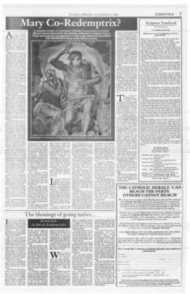Page 10, 22nd August 1997
Page 10

Report an error
Noticed an error on this page?If you've noticed an error in this article please click here to report it.
Tags
Share
Related articles
St. Peter's Crypt Altars Blessed
Asceticism Made Monks Weak At The Knee
Outburst At Commons Mass
Stained Glass Windows And Christian Icons
All Austrians Honour Their Cardinal
Cardinal vices?
IBECAME IN'EERESTED in representations of grossly over-indulgent men of the Church in July this year, when the British MedicalJournal reported a study of skeletons beneath the crypt of St Stephen's Monastery in Jerusalem. It showed that almost all the monks had arthrifis of the knees. The skeletons were about 1,500 years old. "The assumption must be that the damage was associated with frequent kneeling as the monks went through their daily pattern of worship. Present-day monks mostly stand during prayers," remarked the BMJ.
However, Dr Thomas Stuttaford offered an alternative explanation in The Times. He pointed out that osteoarthritis in the knees was commonly associated with obesity. And knees, he said, are seven times more likely than hips to be affected by excess weight.
So, fascinated by the shocking notion that monks might eat too much, I telephoned one of the fathers at Ampleforth. He agreed that modern Benedictines did not kneel as much as they used to and said that he knew of no cases of osteoarduitis from that cause among his brethren. "What the medical archaeologists don't seem to have thought of is the question: is one knee worse than the other? But then they probably don't go to church very often," he said, frostily On the question of clerical gluttony he told me that the popular image of monks as overfed gastropods was "an illusion based on 19th-century romantic pictures". Fr Symondson, a Jesuit who looks after the art collection at Stonyhurst, said that what the Ampleforth monk was probably referring to was the genre of popular Victorian art known as "Cardinal pictures."
Cardinal pictures, he said, depicted an image of sanctified worldliness that appealed to a certain kind of bourgeios Catholic in the late 19th century, and to well-to-do Jews. Brian Brindley, this paper's kind and learned Chief Book Reviewer, put me on to his friend Colin Anson, an art dealer, who was very helpful, told me all about Cardinal pictures and advised me to speak to art dealers MacConnal-Mason in Duke Street, St James's. They are the leading specialists in fine 19thcentury paintings. There I met David Mason Jnr, director of the gallery. He seemed delighted by my inquiry, and in fact had several Cardinal pictures to show me.
Jose Frappa's A Toast to the Cardinal, for sale at MacConnal Mason at L55,000 (not excessive for one of these), is a typical example of the genre. The painting depicts a salon in perhaps Versailles at an unspecified but perhaps ancien regime moment in history, and is intended to represent the domestic quarters of a Cardinal's palace. In it, a richly uphol
stered Cardinal with soft, fleshy pink cheeks and bouffant white hair fluffed out from beneath his skull-cap, flops back in a gilt armchair and holds a pink hand palm outwards in an elaborate pantomime gesture of humility, as a cleric in a white cassock toasts him with a glass of golden liquid. Other ecclesiasts in crimson and purple gaze on with imbecilic, sensual delight.
The incidentals of the scene are those commonly found in such paintings. A magnificent tapestry, a gigantic chandelier, and a sense of orchestrated disarray: an ornamental box seems to have been tipped over on the floor, fine lace handkerchiefs spill over a lacquered occasional table, the table cloth is rumpled. On the table are food remnants and a silver jug of wine. A servant hovers just outside the door; he carries a silver ice bucket containing more champagne.
These pictures have remained more consistently popular than most genres of 19th-century art. Their appeal lies in the high technique, the opulent colour compositions and of course the comic treatment. They appeal to the individual, probably himself rich, who, as David Mason puts it "likes the finer things in life". Mr Mason said all kinds of people bought them, and he confirmed that, interestingly, they are liked by rich Jews. Is it unfair to detect just a slight snigger at the august functionaries of a religion other than their own? Cardinal pictures certainly draw on a strain of anti-clericalism which suited the liberal political mood of their (initially mostly French) purchasers.
FGANCOIS BRUNERY was the leading exponent. He studied under erome in Paris, then went to Rome where he painted the usual classical and mythological subjects. But he had to give this up because his wife objected to the regular viewing of naked models which his work demanded. So in 1877 he accepted a commission to paint a portrait of a Cardinal and out of his initial curiosity about the internal workings of the Church grew the impulse to satirise.
Gustav Courbet had by this time painted scandalous and vehemently and-clerical scenes such as Return from the Conference in which grossly drunk priests stagger home on a country road. And cartoon-style depictions of fat medieval monks already existed. But Brunery and others principally Andrea Lanciini and Jean Georges Vibert painted Cardinals who were jolly and idiotic rather than gross in their overindulgence. As Hook and Poltimore put it in their indispensable Popular Nineteenth Century Painting: "Cardinals might more acceptably be portrayed with the means for that inebriation close at hand, en route for the condition rather than displaying the more extreme characteristics of having arrived at it."
Pheasant for Dinner, for instance, by the French artist Georges Croegaert, shows three senior ecclesiasts sitting round a table decked with claret jugs, a dozen glasses and half-finished silver plates of food. They are all chuckling. One is slumped backwards, presumably pausing for breath; he appears happy enough now, though he may be just moments from succumbing to a massive cerebro-vascular accident brought on by overeating. On the floor, a napkin has been casually tossed, to land on the rumpled rug, beside a three-bottle champagne cooler.
Idiocy is an important theme, and the solemn grandeur of the surroundings only serves to point up the undignified silliness of these noblemen of the Church.
Brunery's The Unwanted Intruder (Cardinal pictures usually have arch fides) shows a frightened cardinal perching on a stool in terror at a mouse, and Lanclini's The Stolen Cap has a Cardinal sternly berating a pet monkey for stealing his skullcap. Vibert's The Cardinal's Favourite Sport shows a fabulously fat Cardinal squeezed in a chair at the water's edge fishing. But of course the clumsy oaf has knocked over his fishing bag and the day's catch is escaping into the water.
It is likely, however, that the public for whom these pictures were painted were at least as interested in the frank luxury of the soft furnishings as in any anti-clerical message, which though good-humoured is sometimes risque and pointed. Vibert's The Indulgence has a stereotypical Cardinal, smiling they usually are as he inspects a poster advertising indulgences. His personal indulgences are rather more sublunary: in the background his table groans with food and wine; he is smoking a cigarette.
Even closer to the bone is Brunery's depiction ofa crimson Cardinal interrupting his coffee there is a golden bowl of dainties in front of him to play with an innocent cherub on his knee as the infant's freshfaced nurse looks on. The innuendo-laden title is The Cardinal's Little Nephew, which is about a subtle as the humour gets.
These days, by comparison with the merciless way their
predecessors were teased, you might think our clergy have an easy time of it.
blog comments powered by Disqus











